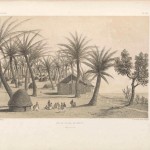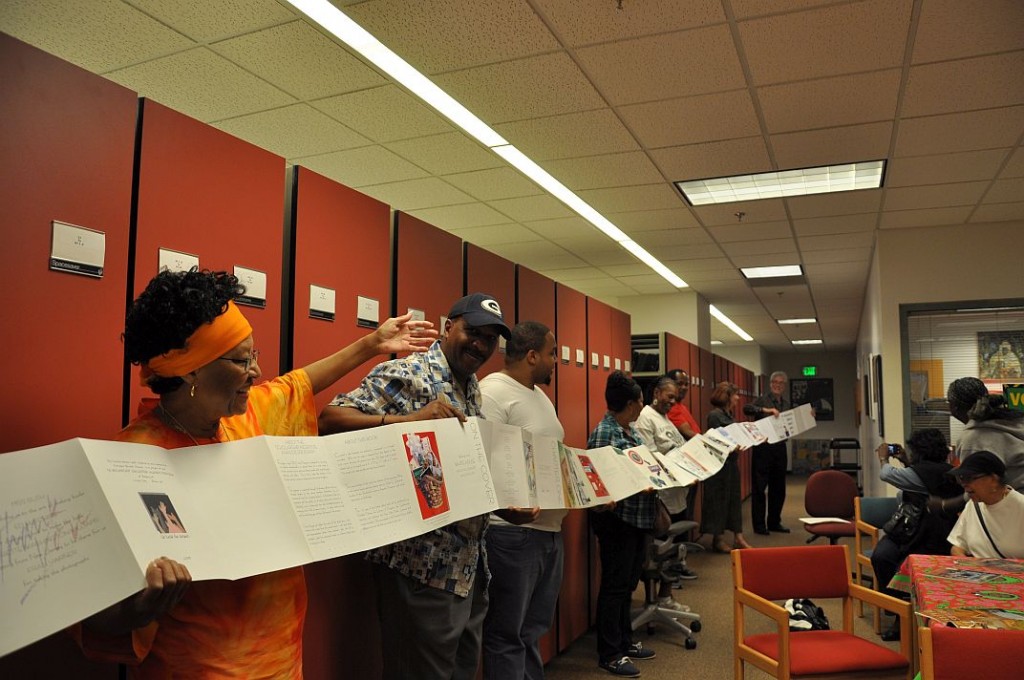The blog post was written by Xavier Courouble for the Warren M. Robbins Library, National Museum of African Art, Smithsonian Institution, on the occasion of the 75th anniversary of Léopold more »
Tag: National Museum of African Art
The Warren M. Robbins Library at the Smithsonian National Museum of African Art celebrates its 45th anniversary this year. From a collection of a few hundred books in Mr. Robbins’ more »
In honor of Women’s History Month, we’re highlighting a book written and illustrated by female artists, The Ultimate Safari. The book is currently featured in our exhibition, Artists’ Books and Africa, which is open until September 2016 and is located in the National Museum of African Art.
The short story “The Ultimate Safari,” by Nadine Gordimer, was originally published in 1991 in Jump and Other Short Stories (London: Bloomsbury).[1] This new edition of The Ultimate Safari is distinguished by its illustrations: twelve lithographs drawn by Aletah Masuku, Alsetah Manthosi, and Dorah Ngomane. Mark Attwood at The Artists’ Press initiated and produced the book in collaboration with Tamar Mason, co-director of the press.
To commemorate the opening of our newest exhibit, Artists’ Books and Africa, six artists will discuss how they develop and produce artist books. Panelists will address the inspiration for and recurring themes within their creations. The history of artist books in Africa will also be discussed. Curator Janet Stanley will lead a tour of the exhibit immediately following the discussion.
 The blog post, second of three, was written by Xavier Courouble, research assistant for Sailors and Daughters: Early Photography and the Indian Ocean, an online exhibition part of the Smithsonian’s National Museum of African Art’s Connecting the Gems of the Indian Ocean: From Oman to East Africa. Read the first post in the series here.
The blog post, second of three, was written by Xavier Courouble, research assistant for Sailors and Daughters: Early Photography and the Indian Ocean, an online exhibition part of the Smithsonian’s National Museum of African Art’s Connecting the Gems of the Indian Ocean: From Oman to East Africa. Read the first post in the series here.
From 1836 to 1848, successively in command of the corvette “La Prévoyante,” “La Dordogne,” and finally the frigate “Le Ducouëdic,” Charles Guillain (1808-1875) navigated the Indian Ocean from the Cape of Good Hope to the western coast of the Indian sub-continent. During his several missions he accumulated extensive knowledge on Zanzibar, Madagascar, the Comoros, as well as the Swahili and Somali coast of Africa. Accounts of these expeditions were all published and gave this St. Simonien a solid reputation of ethnologist and geographer. Yet a certain degree of confusion remains of the political and commercial purposes of his ambitious campaigns of exploration, influenced by personal convictions, regional aspirations, and France’s global interest in the region.
The blog post, first of three, was written by Xavier Courouble, research assistant for Sailors and Daughters: Early Photography and the Indian Ocean, an online exhibition part of the Smithsonian’s National Museum of African Art’s Connecting the Gems of the Indian Ocean: From Oman to East Africa.
Recovering from loss of empire following Napoleon’s defeat at Waterloo in 1815, the French sought to re-establish commerce and colonies in the Indian Ocean. The task fell to Charles Guillain, who led a French expedition to the Swahili coast of Eastern Africa in 1846-1848. Our record of his travels is enshrined in a magisterial 3-volume work Documents sur l’histoire, la géographie, et le commerce de l’Afrique orientale and the accompanying atlas folio of engravings and maps, Voyage à la côte orientale d’Afrique.
The Smithsonian Libraries has digitized the complete work of the volumes held by the Warren M. Robbins Library at the National Museum of African Art.

This summer the Warren M. Robbins Library, National Museum of African Art (AfA) and the American Art Museum/National Art Museum Library (AAPG) hosted a group of 54 visitors from Co-op City in the Bronx, NY to recognize the acquisition of an artists’ book into the AAPG Library’s collection.
